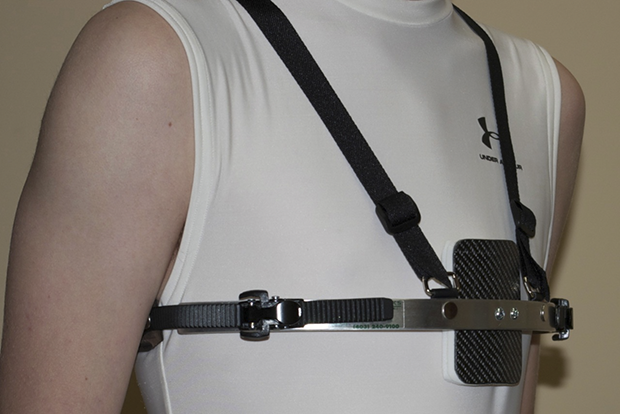Bracing results in significant improvements in Pectus carinatum
Comfort is the key because the brace is worn continuously to provide compression during regular daily activity. Patients are more compliant with the Braceworks PC brace and encouraging results are often apparent early in treatment. Compressive bracing improves Pectus carinatum without surgery, in many cases.
Each Braceworks PC brace is custom fitted and unobtrusive. The brace is lightweight and low-profile – designed specifically for the treatment of anterior wall chest deformities. Self-adjusting, ratcheting buckles allow the patient to adjust pressure.
| Background of the condition |
Pectus carinatum, PC, or so-called Pigeon Chest is one of a spectrum of anterior chest wall developmental anomalies involving an idiopathic overgrowth of the costal cartilages resulting in protrusion defect of the sternum.
The cause of PC is unknown. However, it may be genetically linked with recurrence in families. PC may occur as a solitary abnormality or in association with other genetic disorders or syndromes. The overall prevalence of PC is 0.06 percent and it is more common in boys with a male to female ratio of 4:1. Deformity is usually present from early childhood, but it’s becoming much more prominent in adolescents, during the phase of linear growth. There is a strong correlation between teenage growth and worsening of Pectus deformities. The majority of patients are completely asymptomatic. Symptoms are frequently related to some other associated anomaly (e.g., scoliosis, congenital heart disease or pulmonary involvement).
The classical management of PC has been primarily surgical, involving variations of the Ravitch procedure, a re-section of the deformed costal cartilages along with sternal osteotomy. A rather invasive, not to mention painful, surgical procedure with relatively good results yet long-term worsening of the cosmetic appearance and decreased chest wall compliance over time.
Non-surgical treatments of PC including compressive orthoses were first proposed by Drs. Haje and Raymundo of Brazil in 1979. Compressive orthoses are designed to place the external forces on the point of the most prominent sternal protrusion of the deformity to provide continued pressure to stimulate bone and cartilages remodeling.
Dr. Richard Dewar of the Alberta Children’s Hospital and Marc Schneider BPE, CO at Braceworks adapted the non-surgical brace therapy in 1992. The 15 year collaboration developed clinical treatment alongside device design and today, the Calgary Protocol provides an effective, non-operative alternative for the treatment Pectus carinatum.
Marc Schneider has since developed a lightweight, low-profile, dynamic brace incorporating self-adjusting ratcheting buckles that allow the patient to control pressure and ensure comfort. The improved brace has increased patient adoption and compliance of the intervention and Marc works closely with the Calgary protocol team.
Plasticity of the chest wall was observed in research by Donald Nuss et al, and motivated further clinical research reported in Bracing for Pectus Carinatum — The Calgary Protocol, June 2005. Similar remodelling for PC in response to chronic pressure using an orthoses with cosmetically superior, non-operative results and high rates of compliance.
| References |
The Calgary protocol for bracing of pectus carinatum: a preliminary report, Kravarusic D, Dicken BJ, Dewar R, Harder J, Poncet P, Schneider M, Sigalet DL. J Pediatr Surg. 2006 May;41(5):923-6.
Twenty-one years of experience with minimally invasive repair of pectus excavatum by the Nuss procedure in 1215 patients, Kelly RE, Goretsky MJ, Obermeyer R, Kuhn MA, Redlinger R, Haney TS, Moskowitz A, Nuss D. Ann Surg. 2010 Dec;252(6):1072-81. doi: 10.1097/SLA.0b013e3181effdce.
Considerações sobre deformidades da parede torácica anterior e apresentação de tratamento conservador para as formas com componentes de protrusão, Haje, S.A. and Raymundo, J.L.P., 1979. Rev Bras Ortop. 14(4), pp.167-178.
| Further reading |
ORTHOPEDIC APPROACH TO PECTUS DEFORMITIES: 32 YEARS OF STUDIES, Haje SA, de Podestá Haje D. Rev Bras Ortop. 2015 Nov 16;44(3):191-8. doi: 10.1016/S2255-4971(15)30067-7. Full text, PDF
Chest wall anomalies: pectus excavatum and pectus carinatum, Goretsky MJ, Kelly RE Jr, Croitoru D, Nuss D. Adolesc Med Clin. 2004 Oct;15(3):455-71. doi: 10.1016/j.admecli.2004.06.002.
Preliminary Results of Orthotic Treatment of Pectus Deformities in Children and Adolescents, Haje SA, Bowen JR. J Pediatr Orthop. 1992 Nov-Dec;12(6):795-800.
Pectus deformities, GIEM RN, PAULSEN GA, DYKES J. Calif Med. 1961 May;94(5):306-9. PDF

